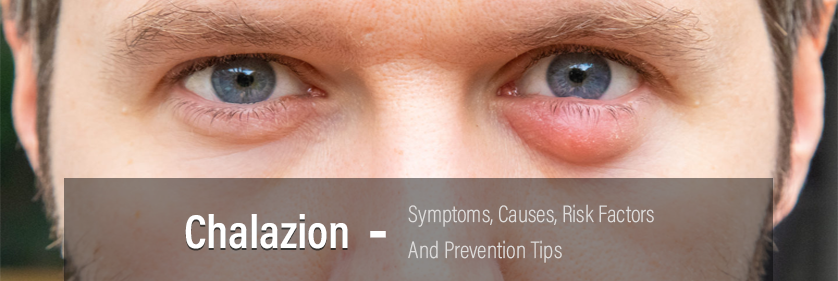Chalazion- Symptoms, Causes, Risk Factors and Prevention Tips
A chalazion is the eyelid is a slight swelling or lump. It can begin as a tender, small red area in the eyelid. Days later, it may change to a painless lump in the eyelid. A chalazion is identical to another bump which may appear called a sty on the eyelid. Here will know about the Chalazion and its Symptoms, Causes, Risk Factors and Prevention tips.
In comparison to a chalazion, a sty is caused by a bacterial infection in the eyelash root and the bump occurs at the eyelid’s bottom. Often a chalazion on the inside of the eyelid may begin as a sty. A sty is painful; usually, a chalazion is not. A chalazion occurs on the eyelid further back, too. But care for both conditions is similar.
Chalazion Symptoms
A chalazion starts with a small area that, when touched, maybe red, swollen, and sore or painful. The pain usually goes away after a few days and a bump or lump remains.
You may also have:
- Watery eyes
- Mild eye irritation
- Blurry vision
When to see a doctor
Most chalazion is harmless to your eye and won’t affect your ability to see clearly. Try self-care measures first, such as applying a warm washcloth to your closed eyelid for five to 10 minutes several times a day and gently massaging the eyelid. Contact your doctor if:
- The chalazion doesn’t start to improve after 48 hours
- Redness and swelling affect the entire eyelid or spreads over your cheek or other areas of your face
Causes of Chalazion
Small glands lining the edge of the eyelids produce oil that helps to lubricate the surface of the eye (meibomian glands). When one of these glands becomes blocked, oil backs up inside the gland and forms a bump in the eyelid. The oily materials will irritate the surrounding eyelid skin if the gland ruptures, causing it to become red, swollen, and painful.
What are the risk factors for a chalazion?
A number of factors increase the risk of developing a chalazion. Not all people with risk factors will get a chalazion. Risk factors for a chalazion include:
- Blepharitis (inflammation of the eyelid margin)
- Poor eyelid hygiene leading to accumulation of lid debris (clogging gland openings)
- Rosacea (inflammatory skin condition characterized by reddening of the skin of the nose and cheeks, sometimes accompanied by broken veins and pimples)
- Seborrheic dermatitis (common inflammatory skin condition characterized by flaky white or yellow scales)
- Tuberculosis (serious infection affecting the lungs and other organs)
- Viral infection
Complications
Nonetheless, a chalazion is known to be mostly harmless but can cause several complications-
- Cosmetic problems: Lump on eyelid can cause significant cosmetic disfigurement of eyes and become a problem in appearance. Progressive Chalazion can lead to disfigurement of eyelids. Chalazion cured or surgery to remove it can leave a scar on the eyelid.
- Infection of Chalazion and Orbital Cellulitis: Chalazia is not usually contaminated. Accumulated fluid in Chalazion is sterile but can often get infected and can spread rapidly in entire eyelids and eyes leading to intense redness, tenderness, swelling, etc. This can cause difficulty in opening the eyelid. It can lead to fever, chills, popping out of eyes, photophobia. This results in orbital Cellulitis which is a serious situation and needs immediate medical attention.
- Loss of eyelash: Progressive chalazion can result in loss of eyelids.
- Astigmatism: Pressure on cornea by a large Chalazion can cause Astigmatism. Astigmatism is the abnormal curvature of cornea. It can cause difficulty in proper vision. This can give rise to the need to knife under.
- Recurrence: Mostly Chalazion once subsides will not come back but in few it may recur again and again.
- Dry eye: Though rare but blockage of oil producing Meibomian gland can cause dry eyes. Multiple Chalazia are hazards for dry eyes because the oil lubricates the eye.
Prevention Tips
- You can’t always stop having a chalazion. This is especially true if you’re prone to this type of eye problem. But there are a few things that you can do to prevent this condition:
- Before touching the eyes always wash your hands
- Make sure that anything that comes in contact with your eyes, such as contact lenses and glasses, is clean.
- When you have a disease that raises your risk of developing chalazia, follow directions from your doctor to help you manage it.
